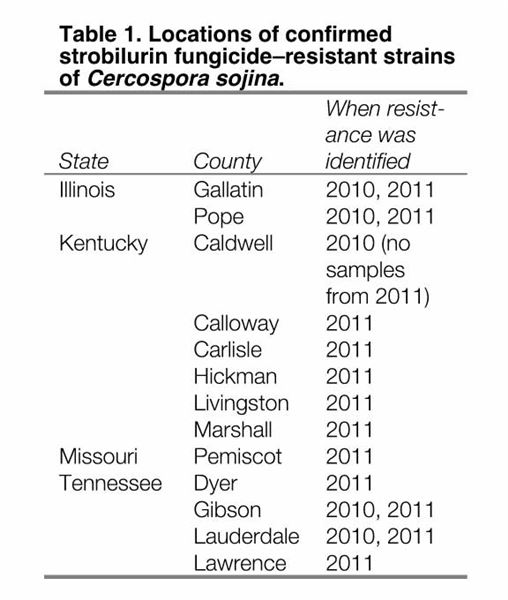More Strobilurin Fungicide-Resistant Strains Of The Causal Agent Of Frogeye Leaf Spot Of Soybean
URBANA, ILL.
As I reported a year ago, Cercospora sojina) resistant to strobilurin fungicides were documented for the first time in western Tennessee in 2010. Since then, similar findings in southern Illinois and western Kentucky have been confirmed from samples also collected in 2010. Additional samples were collected from soybean fields this year, and isolates of C. sojina were recovered and tested for strobilurin fungicide resistance. The counties in Illinois and Tennessee that were found to have fungicide-resistant strains of C. sojina in 2010 also had fungicide-resistant strains present in 2011. In addition, new counties in Tennessee, Kentucky, and Missouri have been confirmed to have strobilurin fungicideresistant strains of C. sojina (Table 1).
Strobilurin fungicide active ingredients currently registered on soybean include azoxystrobin (found in Quadris, Quilt, and Quilt Xcel), fluoxastrobin (Evito), pyraclostrobin (Headline), and trifloxystrobin (Stratego, Stratego YLD). The Fungicide Resistance Action Committee (FRAC; www.frac.info) classifies the strobilurin fungicides as being at high risk for having resistance develop in targeted fungi. Any time a fungicide is applied to a crop, a selection pressure takes place, and individuals in the fungal pathogen population with reduced sensitivity to that fungicide are selected out. With additional applications of fungicides in the same fungicide class, a greater selection pressure is applied, and the risk increases for selecting out fungicide-resistant strains of plant pathogenic fungi.

To reduce this risk, the following tactics are recommended for managing frogeye leaf spot:
• First and foremost, plant a variety with high resistance to frogeye leaf spot, particularly in areas with a history of damaging levels of the disease. Resistant varieties are the best way to manage frogeye leaf spot.
If you have planted a susceptible variety in a risk-prone area and plan to apply fungicide, choose fungicides from different classes. Preliminary results from greenhouse and field studies at the University of Illinois with strobilurin fungicide-resistant strains of C. sojina indicate that many triazole fungicides (Proline, TopGuard, Domark, etc.) and thiophanate methyl fungicide (Topsin and other trade names) were effective in reducing frogeye leaf spot severity compared with strobilurin fungicides and the nontreated control.
• Apply a foliar fungicide only to control plant diseases. Every time a fungicide application is made, pressure is applied that selects out individuals in the fungal pathogen population that may have reduced sensitivity to fungicides. Applying a fungicide only when it is needed – based on disease risk and scouting observations – reduces selection pressure and slows the development and spread of fungicide-resistant isolates.
My thanks to the Illinois Soybean Association for funding much of this research. In addition, I thank Melvin Newman (University of Tennessee), Don Hershman (University of Kentucky), and others for sending samples to my laboratory for testing. Δ
DR. CARL A. BRADLEY: Professor Crop Sciences, University of Illinois